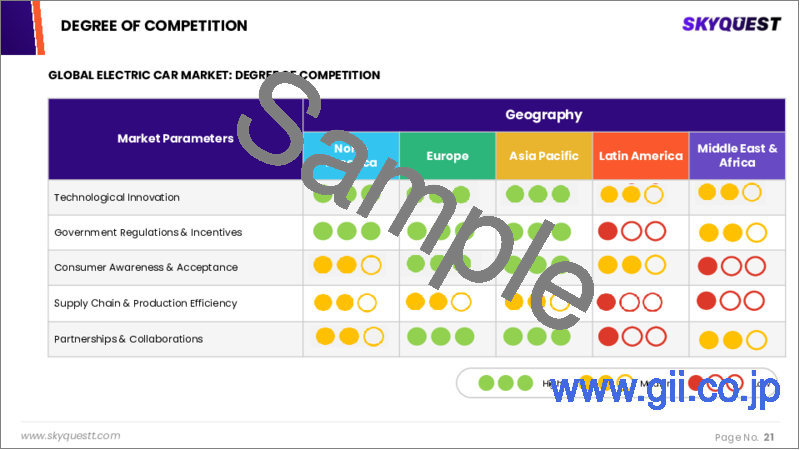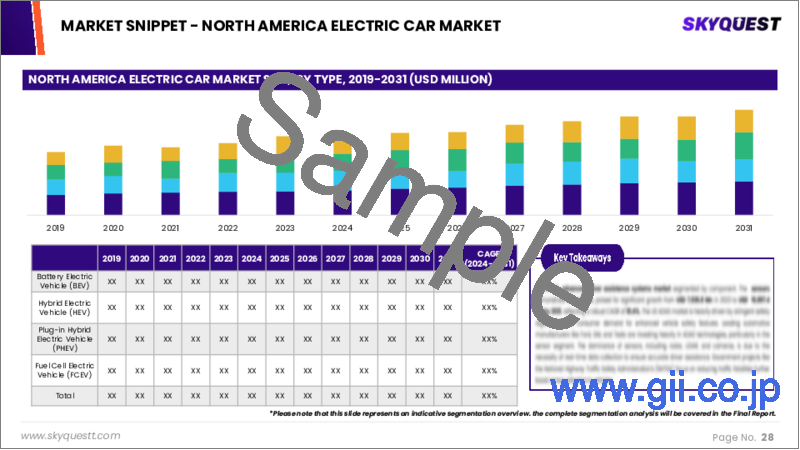|
|
市場調査レポート
商品コード
1533639
電気自動車の市場規模、シェア、成長分析:コンポーネント別、車両クラス別、最高速度別、地域別 - 産業予測、2024年~2031年Electric Car Market Size, Share, Growth Analysis, By Component (Battery Cells & Packs, Motor), By Vehicle Class (Mid-priced, Low-priced), By Top Speed (<125 MPH, >125 MPH), By Region - Industry Forecast 2024-2031 |
||||||
|
|||||||
| 電気自動車の市場規模、シェア、成長分析:コンポーネント別、車両クラス別、最高速度別、地域別 - 産業予測、2024年~2031年 |
|
出版日: 2024年08月06日
発行: SkyQuest
ページ情報: 英文 165 Pages
納期: 3~5営業日
|
- 全表示
- 概要
- 目次
世界の電気自動車の市場規模は、2022年に3,413億4,000万米ドルとなり、予測期間(2024年~2031年)のCAGRは13.7%で、2023年の3,881億米ドルから、2031年までには1兆840億米ドルに成長する見通しです。
電気自動車市場は、技術の進歩、環境意識の高まり、支援政策により急速に拡大しています。バッテリー電気自動車(BEV)、プラグインハイブリッド電気自動車(PHEV)、燃料電池電気自動車(FCEV)は、この変革の最前線にあります。電気のみで走行するBEVは、内燃機関車(ICE)に比べて乗車定員に若干の制限があるにもかかわらず、バッテリー技術の向上により航続距離が延び、コストが削減されたため、普及が進んでいます。ハイブリッド電気自動車は、電気のみの自動車に完全に移行する準備ができていない人に対応するため、電気動力と従来のエンジンを組み合わせたバランスの取れた選択肢を提供します。電気自動車の販売台数の伸びは、特に環境的に持続可能な選択肢を求める大都市圏において、よりクリーンで手頃な価格の交通手段を求める需要に促進されています。高速充電や過充電ステーションなどの充電インフラの改善により、充電時間に関する以前の懸念が解消され、電気自動車がより実用的になっています。さらに、V2B、V2H、V2G、V2V、V2Xのようなスマートグリッド用途を含む車両接続技術の進歩は、高度なスマートグリッドやスマートシティとの統合を促進し、電気自動車が周囲の構造物と通信し、再生可能エネルギーの採用をサポートすることを可能にします。政府の政策やインセンティブも、電気自動車市場の推進に大きな役割を果たしています。多くの政府は、電気自動車の購入を奨励するため、税額控除やその他のインセンティブを提供しています。さらに、ますます厳しくなる排ガス規制は、自動車メーカーに環境にやさしく経済的に実行可能な自動車の生産を促しています。
目次
イントロダクション
- 調査の目的
- 定義
- 市場範囲
調査手法
- 情報調達
- 二次・一次情報源
- 市場規模予測
- 市場の前提条件と制限
エグゼクティブサマリー
- 市場概要見通し
- 供給需要動向分析
- セグメント別機会分析
市場力学と見通し
- 市場力学
- 促進要因
- 機会
- 抑制要因
- 課題
- ポーターの分析
主要な市場の考察
- 主要な成功要因
- 競合の程度
- 技術分析
- 規制分析
- スタートアップ分析
- 特許分析
- バリューチェーン分析
- ケーススタディ分析
- 価格分析
- サプライチェーン分析
- 主要な投資機会
- 市場の魅力指数
- 市場エコシステム
電気自動車市場:コンポーネント別
- 市場概要
- バッテリーセル・パック
- オンボードチャージ
- モーター
- リデューサー
- 燃料スタック
- パワーコントロールユニット
- バッテリー管理システム
- 燃料処理装置
- パワーコンディショナー
- エアコンプレッサー
- 加湿器
電気自動車市場:車両タイプ別
- 市場概要
- 乗用車
- 商用車
電気自動車市場:車両クラス別
- 市場概要
- 低価格
- 中価格
- 高級
電気自動車市場:最高速度別
- 市場概要
- 125MPH以下
- 125MPH以上
電気自動車市場:車両駆動方式別
- 市場概要
- 前輪駆動
- 後輪駆動
- 全輪駆動
電気自動車市場:EV充電ポイントタイプ別
- 市場概要
- 通常充電
- スーパー充電
電気自動車市場:車両接続別
- 市場概要
- V2BまたはV2H
- V2G
- V2V
- V2X
電気自動車市場:推進力別
- 市場概要
- BEV
- PHEV
- FCEV
電気自動車市場:エンドユーザー別
- 市場概要
- プライベート
- 商用フリート
電気自動車市場規模:地域別
- 市場概要
- 北米
- 米国
- カナダ
- 欧州
- ドイツ
- スペイン
- フランス
- 英国
- イタリア
- その他欧州地域
- アジア太平洋
- 中国
- インド
- 日本
- 韓国
- その他アジア太平洋
- ラテンアメリカ
- ブラジル
- その他ラテンアメリカ地域
- 中東・アフリカ(MEA)
- GCC諸国
- 南アフリカ
- その他中東・アフリカ地域
競合情勢
- 上位5社の比較
- 主要企業の市場ポジショニング(2023年)
- 主要な市場企業が採用した戦略
- 市場における最近の活動
- 主要企業の市場シェア(2023年)
主要企業プロファイル
- BMW AG(Germany)
- BYD Company Limited(China)
- Daimler AG(Germany)
- Energica Motor Company(Italy)
- Ford Motor(US)
- General Motors(US)
- Hyundai Motor Company(South Korea)
- Karma Automotive(China)
- Kia Corporation(South Korea)
- Lucid Group Inc.(US)
- Mahindra Electric Mobility Limited(India)
- Nissan Motors Co., Ltd.(Japan)
- Tata Motors(India)
- Tesla, Inc.(US)
- Toyota Motor Corporation(Japan)
- Volkswagen AG(Germany)
- WM Motor(China)
- Xiaopeng Motors(China)
Global Electric Car Market size was valued at USD 341.34 billion in 2022 and is poised to grow from USD 388.10 billion in 2023 to USD 1084 billion by 2031, growing at a CAGR of 13.7% during the forecast period (2024-2031).
The electric car market has been expanding rapidly due to advancements in technology, heightened environmental awareness, and supportive policies. Battery electric vehicles (BEVs), plug-in hybrid electric vehicles (PHEVs), and fuel cell electric vehicles (FCEVs) are at the forefront of this transformation. BEVs, which operate entirely on electricity, have become more prevalent as battery technology improves, enhancing range and reducing costs, despite some limitations in seating capacity compared to internal combustion engine (ICE) vehicles. Hybrid electric vehicles offer a balanced option, combining electric power with traditional engines to accommodate those who are not ready to fully transition to electric-only vehicles. The growth in electric car sales is driven by the demand for cleaner, more affordable transportation solutions, particularly in large urban areas seeking environmentally sustainable options. Improvements in charging infrastructure, such as high-speed charging and supercharging stations, have addressed previous concerns about charging times, making electric vehicles more practical. Additionally, advancements in vehicle connectivity technologies, including smart grid applications like V2B, V2H, V2G, V2V, and V2X, facilitate integration with advanced smart grids and smart cities, allowing electric vehicles to communicate with surrounding structures and support the adoption of renewable energy. Government policies and incentives also play a significant role in driving the electric car market. Many governments offer tax credits and other incentives to encourage the purchase of electric vehicles. Moreover, increasingly stringent emission standards are pushing automotive manufacturers to produce environmentally friendly and economically viable vehicles.
Top-down and bottom-up approaches were used to estimate and validate the size of the Global Electric Car market and to estimate the size of various other dependent submarkets. The research methodology used to estimate the market size includes the following details: The key players in the market were identified through secondary research, and their market shares in the respective regions were determined through primary and secondary research. This entire procedure includes the study of the annual and financial reports of the top market players and extensive interviews for key insights from industry leaders such as CEOs, VPs, directors, and marketing executives. All percentage shares split, and breakdowns were determined using secondary sources and verified through Primary sources. All possible parameters that affect the markets covered in this research study have been accounted for, viewed in extensive detail, verified through primary research, and analyzed to get the final quantitative and qualitative data.
Global Electric Car Market Segmental Analysis
The global electric car market is segmented by component, vehicle type, vehicle class, top speed, vehicle drive type, EV charging point type, vehicle connectivity, propulsion, end user, and region. Based on component, the market is segmented into battery cells & packs, on-board charge, motor, reducer, fuel stack, power control unit, battery management system, fuel processor, power conditioner, air compressor, and humidifier. Based on vehicle type, the market is segmented into passenger cars, and commercial vehicles. Based on vehicle class, the market is segmented into low-priced, mid-priced, and luxury. Based on top speed, the market is segmented into <125 MPH, and >125 MPH. Based on vehicle drive type, the market is segmented into front wheel drive, rear wheel drive, and all-wheel drive. Based on EV charging point type, the market is segmented into normal charging, and super charging. Based on vehicle connectivity, the market is segmented into V2B or V2H, V2G, V2V, and V2X. Based on propulsion, the market is segmented into BEV, PHEV, and FCEV. Based on end user, the market is segmented into private, and commercial fleets. Based on region, the market is segmented into North America, Europe, Asia Pacific, Middle East and Africa, and Latin America.
Drivers of the Global Electric Car Market
Governments around the world have introduced stricter emissions standards and regulations to promote the use of electric vehicles. These measures, which include tax credits, rebates, subsidies, and grants, have significantly contributed to the growing adoption of electric vehicles. Among the regions leading in such initiatives, Europe stands out, with Scandinavian countries like Norway and Germany implementing aggressive policies and fostering a supportive ecosystem for e-mobility. The combination of enhanced regulations and financial incentives has accelerated the penetration of electric vehicles in various markets. By encouraging the shift to cleaner transportation options, these measures are helping to drive the growth of the electric vehicle sector and contribute to broader environmental goals.
Restraints in the Global Electric Car Market
Despite a general decline in costs over time, electric vehicles still typically have a higher acquisition cost compared to internal combustion engine vehicles. This cost barrier can limit the number of potential customers, particularly in regions with lower per capita incomes or where fewer individuals can afford the available subsidies. For instance, even in Europe, where internet usage is above the global average due to widespread fixed broadband subscriptions, there remains a challenge in balancing costs to make electric vehicles accessible to all consumer segments.
Market Trends of the Global Electric Car Market
To address current infrastructure challenges, the expansion of charging networks has seen steady progress, supported by both government and private sector investments. The development of advanced charging solutions, such as mega-charging stations and wireless charging technology, aims to improve the electric vehicle charging experience. Europe, in particular, has been a frontrunner in this area, with substantial capital investments directed towards enhancing and expanding the charging infrastructure.
Table of Contents
Introduction
- Objectives of the Study
- Definitions
- Market Scope
Research Methodology
- Information Procurement
- Secondary & Primary Data Sources
- Market Size Estimation
- Market Assumptions & Limitations
Executive Summary
- Market Overview Outlook
- Supply Demand Trend Analysis
- Segmental Opportunity Analysis
Market Dynamics & Outlook
- Market Dynamics
- Drivers
- Opportunities
- Restraints
- Challenges
- Porters Analysis
- Competitive rivalry
- Threat of Substitute Products
- Bargaining Power of Buyers
- Threat of New Entrants
- Bargaining Power of Suppliers
Key Market Insights
- Key Success Factors
- Key Success Factors
- Degree of Competition
- Technology Analysis
- Regulatory Analysis
- Startup Analysis
- Patent Analysis
- Value Chain Analysis
- Case Study Analysis
- Pricing Analysis
- Supply Chain Analysis
- Top Investment Pockets
- Market Attractiveness Index
- Market Ecosystem
Electric Car Market by Component
- Market Overview
- Battery Cells & Packs
- On-Board Charge
- Motor
- Reducer
- Fuel Stack
- Power Control Unit
- Battery Management System
- Fuel Processor
- Power Conditioner
- Air Compressor
- Humidifier
Electric Car Market by Vehicle Type
- Market Overview
- Passenger Cars
- Commercial Vehicles
Electric Car Market by Vehicle Class
- Market Overview
- Low-priced
- Mid-priced
- Luxury
Electric Car Market by Top Speed
- Market Overview
- <125 MPH
- >125 MPH
Electric Car Market by Vehicle Drive Type
- Market Overview
- Front Wheel Drive
- Rear Wheel Drive
- All Wheel Drive
Electric Car Market by EV Charging Point Type
- Market Overview
- Normal Charging
- Super Charging
Electric Car Market by Vehicle Connectivity
- Market Overview
- V2B or V2H
- V2G
- V2V
- V2X
Electric Car Market by Propulsion
- Market Overview
- BEV
- PHEV
- FCEV
Electric Car Market by End User
- Market Overview
- Private
- Commercial Fleets
Electric Car Market Size by Region
- Market Overview
- North America
- USA
- Canada
- Europe
- Germany
- Spain
- France
- UK
- Italy
- Rest of Europe
- Asia Pacific
- China
- India
- Japan
- South Korea
- Rest of Asia-Pacific
- Latin America
- Brazil
- Rest of Latin America
- Middle East & Africa (MEA)
- GCC Countries
- South Africa
- Rest of MEA
Competitive Landscape
- Top 5 Player Comparison
- Market Positioning of Key Players, 2023
- Strategies Adopted by Key Market Players
- Recent Activities in the Market
- Key Companies Market Share (%), 2023
Key Company Profiles
- BMW AG (Germany)
- Company Overview
- Business Segment Overview
- Financial Updates
- Key Developments
- BYD Company Limited (China)
- Company Overview
- Business Segment Overview
- Financial Updates
- Key Developments
- Daimler AG (Germany)
- Company Overview
- Business Segment Overview
- Financial Updates
- Key Developments
- Energica Motor Company (Italy)
- Company Overview
- Business Segment Overview
- Financial Updates
- Key Developments
- Ford Motor (US)
- Company Overview
- Business Segment Overview
- Financial Updates
- Key Developments
- General Motors (US)
- Company Overview
- Business Segment Overview
- Financial Updates
- Key Developments
- Hyundai Motor Company (South Korea)
- Company Overview
- Business Segment Overview
- Financial Updates
- Key Developments
- Karma Automotive (China)
- Company Overview
- Business Segment Overview
- Financial Updates
- Key Developments
- Kia Corporation (South Korea)
- Company Overview
- Business Segment Overview
- Financial Updates
- Key Developments
- Lucid Group Inc. (US)
- Company Overview
- Business Segment Overview
- Financial Updates
- Key Developments
- Mahindra Electric Mobility Limited (India)
- Company Overview
- Business Segment Overview
- Financial Updates
- Key Developments
- Nissan Motors Co., Ltd. (Japan)
- Company Overview
- Business Segment Overview
- Financial Updates
- Key Developments
- Tata Motors (India)
- Company Overview
- Business Segment Overview
- Financial Updates
- Key Developments
- Tesla, Inc. (US)
- Company Overview
- Business Segment Overview
- Financial Updates
- Key Developments
- Toyota Motor Corporation (Japan)
- Company Overview
- Business Segment Overview
- Financial Updates
- Key Developments
- Volkswagen AG (Germany)
- Company Overview
- Business Segment Overview
- Financial Updates
- Key Developments
- WM Motor (China)
- Company Overview
- Business Segment Overview
- Financial Updates
- Key Developments
- Xiaopeng Motors (China)
- Company Overview
- Business Segment Overview
- Financial Updates
- Key Developments





